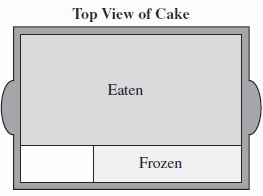General Information
Test Item Specifications
Students may identify procedures for multiplying or dividing fractions and/or decimals in the context of expressions, equations, or real-world situations.
Students will choose the correct graphic representation of multiplication or division problems involving fractions or decimals.
Items may include mixed numbers, fractions, and/or decimals.
Items may include decimals through the hundredths place.
Denominators of fractions used must be less than or equal to 16.
Items will not require the student to simplify fractions.
Items may not include a combination of fractions and decimals.
Items should be set in a real-world or mathematical context.
Graphical representations of fractions, mixed numbers, and/or decimals may be used, as appropriate.
Sample Test Items (1)
| Test Item # | Question | Difficulty | Type |
| Sample Item 1 | Merrill baked a cake in the shape of a rectangular prism for a party. After the party, 1/4 of the cake had not been eaten. Merrill froze 2/3 of the remaining cake. A diagram of the portion eaten and the portion frozen is shown below.
Which expression can be used to find the fraction of the original whole cake Merrill froze? |
N/A | MC: Multiple Choice |
Related Resources
Lesson Plans
| Name | Description |
| Sandy's Candy Machine | In this Model Eliciting Activity (MEA), students will use the 4 operations with decimal numbers and calculate profit (including negative numbers) as well as use the resulting data to help a business owner make decisions about their candy stores. Model Eliciting Activities, MEAs, are open-ended, interdisciplinary problem-solving activities that are meant to reveal students’ thinking about the concepts embedded in realistic situations. MEAs resemble engineering problems and encourage students to create solutions in the form of mathematical and scientific models. Students work in teams to apply their knowledge of science and mathematics to solve an open-ended problem, while considering constraints and tradeoffs. Students integrate their ELA skills into MEAs as they are asked to clearly document their thought process. MEAs follow a problem-based, student-centered approach to learning, where students are encouraged to grapple with the problem while the teacher acts as a facilitator. To learn more about MEA’s visit: https://www.cpalms.org/cpalms/mea.aspx |
| Dividing Fractions | In this lesson students will explore the different methods available for dividing fractions through a student-based investigation. The teacher will facilitate the discussion, but the students will discover the different methods on their own or with a partner as they work through the different steps. |
| Multiplying a Fraction by a Fraction | Students will multiply a fraction times a fraction. The students will section off a square through rows and columns that will represent the strategy of multiplying numerators and then denominators. |
Professional Development
| Name | Description |
| Fractions, Percents, and Ratios, Part A: Models for Multiplication and Division of Fractions | This professional development module shows teachers how to use area models to understand multiplication and division of fractions. |
Project
| Name | Description |
| Fractions - Cookie Project | This Math Project includes a rubric. |
Teaching Ideas
| Name | Description |
| Why Use the Reciprocal When Dividing Fractions? | Sometimes students ask, "Why are we using the reciprocal when dividing fractions?" This website gives you the language you can use and a visual demonstration of why. |
| Divide Fractions | This interactive resource provides three activities which model the concept of dividing fractions, as well as mixed numbers, by using number lines or circle graphs. It includes the equation showing the standard algorithm. |
Parent Resources
Teaching Idea
| Name | Description |
| Why Use the Reciprocal When Dividing Fractions?: | Sometimes students ask, "Why are we using the reciprocal when dividing fractions?" This website gives you the language you can use and a visual demonstration of why. |


